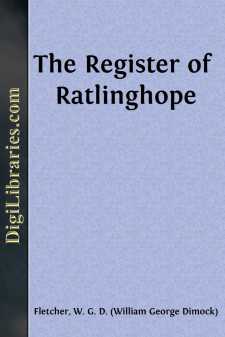Categories
- Antiques & Collectibles 13
- Architecture 36
- Art 48
- Bibles 22
- Biography & Autobiography 813
- Body, Mind & Spirit 142
- Business & Economics 28
- Children's Books 17
- Children's Fiction 14
- Computers 4
- Cooking 94
- Crafts & Hobbies 4
- Drama 346
- Education 46
- Family & Relationships 57
- Fiction 11829
- Games 19
- Gardening 17
- Health & Fitness 34
- History 1377
- House & Home 1
- Humor 147
- Juvenile Fiction 1873
- Juvenile Nonfiction 202
- Language Arts & Disciplines 88
- Law 16
- Literary Collections 686
- Literary Criticism 179
- Mathematics 13
- Medical 41
- Music 40
- Nature 179
- Non-Classifiable 1768
- Performing Arts 7
- Periodicals 1453
- Philosophy 64
- Photography 2
- Poetry 896
- Political Science 203
- Psychology 42
- Reference 154
- Religion 513
- Science 126
- Self-Help 84
- Social Science 81
- Sports & Recreation 34
- Study Aids 3
- Technology & Engineering 59
- Transportation 23
- Travel 463
- True Crime 29
The Register of Ratlinghope
Categories:
Description:
Excerpt
The Register of Ratlinghope.
Ratlinghope is a parish situate on the road from Shrewsbury to Bishop’s Castle, four miles west from Church Stretton and twelve miles south from Shrewsbury, in the hundred of Purslow, rural deanery of Bishop’s Castle, archdeaconry of Ludlow, and diocese of Hereford. The township of Gatten is in Ford hundred. Its area is 5,456 acres, of which 3,756 are arable and pasture, 200 woodland, and about 1,500 common. The population in 1901 was 197. The surface is hilly, and the soil is sand and clay, on a rocky subsoil. An old Roman road, the Portway, runs between Ratlinghope and Church Stretton, and is continued along the crest of the Longmynd in a north-easterly direction. In the neighbourhood are some British camps and tumuli.
Ratlinghope, in Domesday Rotelingehope, means the hope or valley of the children of Rotel, “Rotel” being the Saxon name from which the County of Rutland was called. At the time of the Domesday survey, Rotelingehope was a manor of two hides, which were waste, and was held by Robert fitz Corbet of Earl Roger de Montgomery. In Edward the Confessor’s reign, Seuuard had held it. Robert fitz Corbet was a younger brother of Roger, the builder of Caus Castle; he left two daughters, his heirs, Sibil (or Adela), and Alice. Sibil, who had been one of Henry I.’s mistresses, married Herbert fitz Herbert, whilst Alice became the wife of William Botterell. Before 1209 Ratlinghope was acquired by Walter Corbet, an Augustine Canon, and a relative of Prince Llewelyn ap Jorwerth, who gave him a letter of protection. Walter Corbet founded here a small cell or priory of Augustinian Canons of St. Victor, in connection with Wigmore. Nothing is known of its history, but at the dissolution there was a Prior and 29 Canons; and the possessions of the Priory, valued at £5 11s. 1½d., per annum, were sold in May, 1546, to Robert Longe, citizen and mercer of London.
In 1845 the manor and advowson of Ratlinghope were purchased by Robert Scott, Esq., of Great Barr, M.P. for Walsall, and at his death in 1856 they passed to his son John Charles Addyes Scott, Esq., who died in 1888, and on the death of his widow in 1907, their son, James Robert Scott, Esq., became lord of the manor and patron of Ratlinghope.
Stitt and Gatten, two miles north-west, were members of the Domesday manor of Ratlinghope. Between 1204 and 1210, William de Botterell confirmed a moiety of Stitt to Haughmond Abbey. Robert Corbet, of Caus, also gave to the Canons of Haughmond his culture of Gateden, and an assart situate near their culture of Gatteden. There was a church at Stitt in the reign of Henry II., but since the dissolution of Haughmond Abbey nothing more is heard of it, and its district with Gatten was annexed to the parish of Ratlinghope. W. E. M. Hulton-Harrop, Esq., is lord of the manor of Gatten, which, he inherited in 1866 from his maternal grandfather, Jonah Harrop, Esq.
The Church of St. Margaret, at Ratlinghope, is a small stone building, consisting of nave and chancel, with south porch, and a wooden bell turret. The original Church erected in the 12th century was no doubt the Priory Church also. The Rev....


